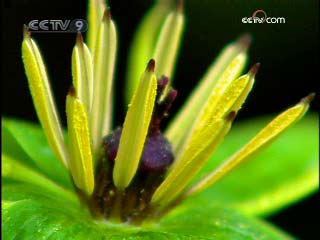------Program code: NS-080821-02894 (what's this?)
Source: CCTV.com
08-21-2008 10:12
 |
In February, the moso bamboo is still covered with snow. The young bamboo shoots have been dormant under the cover for the past three months. On the tip of a bamboo far from the bushes, a cramer butterfly pupa hides among the leaves. Both the pupa and the bamboo shoots are awaiting winter’s end.
A bamboo bug climbs to the tip of the plant. There it gets its first breath of the East Asian monsoon wind that blows from the Pacific into the valleys of Mount Wuyi.
 |
Huanggang is the highest mountain on the southeast Eurasian Continent. Movements of the Earth’s plates many millions of years ago created this green fence, which has protected the sub-tropical forests.
With the help of the wind, the moso bamboo changes its covering. The pupa hanging beneath the bamboo leaf threatens to fall at any moment. On the ground, a cicindelidae awaits.
Its compound eyes can focus instantaneously. It’s also the fastest insect in the world.
The tasty young butterfly is targeted by many hungry hunters.
The leaves will continue changing until the vernal equinox. Once the new leaves come out, they will be responsible for nurturing the next generation. They will produce nutrients in the sunshine, which will be transported to the leaf’s body along stems beneath its surface. The young bamboo shoots are now ready to sprout.
The cramer butterfly is waiting to break open its cocoon. Its wings are taking shape. As the pupa becomes more and more transparent, its eyes can sense the light in the bamboo, projected by the sun.
The first rain in April announces the arrival of spring.
In the vernal warmth, the rain signals to the bamboo shoots that they should sprout.
Once they have sprouted, the bamboo shoots must summon all their energy. Speed is now essential. The first ray of sunlight after the rain triggers an outbreak of competition.
As the fastest-growing plant in the world, the bamboo will rise to over 20 metres in just 45 days.
China is the natural home of the moso bamboo. 85% of all the moso bamboo in the world grows in the vast areas south of the Yangtze River.
The bamboo that grows the tallest in the shortest time will enjoy the most sunshine.
The cramer butterfly is due to celebrate its rebirth this evening. Ever since last summer, it has been eating alianthus prickly ash leaves, in anticipation of this day. The liquid in its body pours to its breast, and the pupa is forced open from inside. Meanwhile, the hunters are waiting in ambush.
In just two minutes, the liquid pours into the wings through the veins.
Editor:Yang
